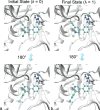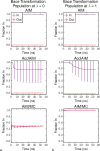Enhanced ligand sampling for relative protein-ligand binding free energy calculations
- PMID: 25906170
- PMCID: PMC4442669
- DOI: 10.1021/acs.jpcb.5b02348
Enhanced ligand sampling for relative protein-ligand binding free energy calculations
Abstract
Free energy calculations are used to study how strongly potential drug molecules interact with their target receptors. The accuracy of these calculations depends on the accuracy of the molecular dynamics (MD) force field as well as proper sampling of the major conformations of each molecule. However, proper sampling of ligand conformations can be difficult when there are large barriers separating the major ligand conformations. An example of this is for ligands with an asymmetrically substituted phenyl ring, where the presence of protein loops hinders the proper sampling of the different ring conformations. These ring conformations become more difficult to sample when the size of the functional groups attached to the ring increases. The Adaptive Integration Method (AIM) has been developed, which adaptively changes the alchemical coupling parameter λ during the MD simulation so that conformations sampled at one λ can aid sampling at the other λ values. The Accelerated Adaptive Integration Method (AcclAIM) builds on AIM by lowering potential barriers for specific degrees of freedom at intermediate λ values. However, these methods may not work when there are very large barriers separating the major ligand conformations. In this work, we describe a modification to AIM that improves sampling of the different ring conformations, even when there is a very large barrier between them. This method combines AIM with conformational Monte Carlo sampling, giving improved convergence of ring populations and the resulting free energy. This method, called AIM/MC, is applied to study the relative binding free energy for a pair of ligands that bind to thrombin and a different pair of ligands that bind to aspartyl protease β-APP cleaving enzyme 1 (BACE1). These protein-ligand binding free energy calculations illustrate the improvements in conformational sampling and the convergence of the free energy compared to both AIM and AcclAIM.
Figures






Similar articles
-
Impact of protein conformations on binding free energy calculations in the beta-secretase 1 system.J Comput Chem. 2024 Sep 5;45(23):2024-2033. doi: 10.1002/jcc.27365. Epub 2024 May 9. J Comput Chem. 2024. PMID: 38725239
-
Sampling and refinement protocols for template-based macrocycle docking: 2018 D3R Grand Challenge 4.J Comput Aided Mol Des. 2020 Feb;34(2):179-189. doi: 10.1007/s10822-019-00257-1. Epub 2019 Dec 26. J Comput Aided Mol Des. 2020. PMID: 31879831 Free PMC article.
-
A PM7 dynamic residue-ligand interactions energy landscape of the BACE1 inhibitory pathway by hydroxyethylamine compounds. Part I: The flap closure process.J Mol Graph Model. 2017 Sep;76:274-288. doi: 10.1016/j.jmgm.2017.07.010. Epub 2017 Jul 14. J Mol Graph Model. 2017. PMID: 28746905
-
Enhanced sampling of glutamate receptor ligand-binding domains.Neurosci Lett. 2019 May 1;700:17-21. doi: 10.1016/j.neulet.2018.04.018. Epub 2018 Apr 14. Neurosci Lett. 2019. PMID: 29665428 Review.
-
Taming Rugged Free Energy Landscapes Using an Average Force.Acc Chem Res. 2019 Nov 19;52(11):3254-3264. doi: 10.1021/acs.accounts.9b00473. Epub 2019 Nov 4. Acc Chem Res. 2019. PMID: 31680510 Review.
Cited by
-
Influence of gauche effect on uncharged oxime reactivators for the reactivation of tabun-inhibited AChE: quantum chemical and steered molecular dynamics studies.J Comput Aided Mol Des. 2018 Jul;32(7):793-807. doi: 10.1007/s10822-018-0130-1. Epub 2018 Jul 6. J Comput Aided Mol Des. 2018. PMID: 29980922
-
Binding Modes and Metabolism of Caffeine.Chem Res Toxicol. 2019 Jul 15;32(7):1374-1383. doi: 10.1021/acs.chemrestox.9b00030. Epub 2019 Jun 11. Chem Res Toxicol. 2019. PMID: 31132250 Free PMC article.
-
Binding Energy Distribution Analysis Method: Hamiltonian Replica Exchange with Torsional Flattening for Binding Mode Prediction and Binding Free Energy Estimation.J Chem Theory Comput. 2016 May 10;12(5):2459-70. doi: 10.1021/acs.jctc.6b00134. Epub 2016 Apr 26. J Chem Theory Comput. 2016. PMID: 27070865 Free PMC article.
-
Accelerated Enveloping Distribution Sampling (AEDS) Allows for Efficient Sampling of Orthogonal Degrees of Freedom.J Chem Inf Model. 2023 Jan 9;63(1):197-207. doi: 10.1021/acs.jcim.2c01272. Epub 2022 Dec 13. J Chem Inf Model. 2023. PMID: 36512416 Free PMC article.
-
Caver Web 1.0: identification of tunnels and channels in proteins and analysis of ligand transport.Nucleic Acids Res. 2019 Jul 2;47(W1):W414-W422. doi: 10.1093/nar/gkz378. Nucleic Acids Res. 2019. PMID: 31114897 Free PMC article.
References
-
- Fasnacht M.; Swendsen R.; Rosenberg J. Adaptive Integration Method for Monte Carlo Simulations. Phys. Rev. E 2004, 69, 056704. - PubMed
Publication types
MeSH terms
Substances
Grants and funding
LinkOut - more resources
Full Text Sources
Other Literature Sources

